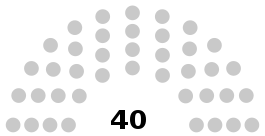Federal National Council
The Federal National Council (FNC) (Arabic: المجلس الوطني الإتحادي, al-Majlis al-Watani al-Ittihadi) is the federal authority of the United Arab Emirates formed to represent the general Emirati people.[1] The FNC consists of 40 members with advisory tasks in the House of Legislative Council. Twenty members are elected by the citizens of the UAE through an electoral college, while the remaining twenty are appointed by the rulers of each emirate.[2][3] The FNC assembly hall is located in the Abu Dhabi, the capital of the UAE.[4]
Federal National Council المجلس الوطني الاتحادي | |
|---|---|
 | |
| Type | |
| Type | |
| History | |
| Founded | 1971 |
| Leadership | |
Saqr Ghobash since 14 November 2019 | |
| Structure | |
| Seats | 40 |
 | |
Political groups | Independent (40) |
Length of term | 4 years |
| Elections | |
| Indirect single non-transferable vote in seven electoral colleges (20 seats) Appointed by rulers of each emirate (20 seats) | |
| Website | |
| official website | |
 |
|---|
| This article is part of a series on the politics and government of the United Arab Emirates |
|
|
|
|
|
|
The National Election Committee (NEC) conducts the election and is authorized to nominate the electoral college members. Any citizen can be selected as a member. The NEC was established in February 2011 by a consensus of the UAE Supreme Council and chaired by the Minister of State for Federal National Council Affairs. The NEC have the authority to look after the election of representatives from all the emirates of the UAE to the Federal National Council (FNC).[3]
History
The Federal National Council (FNC) was formed under the Provisional Constitution of the United Arab Emirates in 1971 as a permanent component of the country's governing structure, which also includes the Supreme Council, President, Cabinet and Judiciary. Before 2006, all members of the FNC were picked by the Rulers of the emirates.
Over the last 43 years, the FNC has discussed hundreds of issues and drafted laws concerning the people and economy of the country. According to the Constitution, federal draft laws first have to pass through the FNC for review and recommendations. Draft laws and amendments formed with help of specialized house committees are presented to the Council for discussion and later sent back to the Cabinet for consideration and approval. Throughout its history, the Council has influenced the Federal Government to draft laws. Original draft laws from the Cabinet are amended by the Council to suit the needs of the citizens which they represent.[5]
The FNC is responsible under the Constitution for examining, and, if it wishes, amending, all proposed federal legislation, and is empowered to summon and to question any Federal Minister regarding Ministry performance. One of the main duties of the FNC is to discuss the annual budget. Specialized sub-committees and a Research and Studies Unit have been formed to assist FNC members to cope with the increasing demands of modern government.[6]
Composition
The composition of the Federal National Council was as follows. Half were elected and half were appointed:[7]
| Emirate | Number of members |
|---|---|
| Abu Dhabi | 8 |
| Dubai | 8 |
| Sharjah | 6 |
| Ras Al Khaimah | 6 |
| Ajman | 4 |
| Fujairah | 4 |
| Umm Al Quwain | 4 |
| Total | 40 |
Speakers of the Federal National Council
| Name | Entered office | Left office | Notes |
|---|---|---|---|
| Thani Abdullah Humaid | 1972 | 1976 | [8][9] |
| Taryam bin Omran Taryam | 1977 | 1981 | [8][9] |
| Hilal bin Ahmed bin Lootah | 1981 | 1991 | [8][9] |
| Al Haj bin Abdullah Al Muhairbi | 1993 | 1996 | [8][9] |
| Mohammed Khalifa Habtour | 1997 | 2003 | [8][9] |
| Saeed Mohammad Al Gandi | 2003 | 2005 | [8][9] |
| Abdul Aziz Al Ghurair | February 2007 | 15 November 2011 | [10][9] |
| Mohammad Al-Murr | 15 November 2011 | 18 November 2015 | [11][9] |
| Amal Al Qubaisi | 18 November 2015 | 14 November 2019 | [7][9] |
| Saqr Ghobash | 14 November 2019 | Incumbent | [7][12] |
Elections
2006 Election
Not all UAE nationals were allowed to vote or run for office. 6,689 out of some 800,000 Emirati citizens in the country were eligible to take part in 2006 election. Those eligible were chosen by the rulers of the emirates.
Women were allowed to vote and run for office but there was no quota to ensure a set number of women were elected as there was in some other Arab countries. Over 14% of candidates were women. By the end of 2003, all forty members of the FNC were male.
Election officials billed the polls as a trial run they hoped will pave the way for universal suffrage in the coming years. Even then, however, only half of the FNC will be elected.[6]
In late 2006, half of the organization was elected.[13] This election was seen as the first steps toward an Emirati democracy.[14]
2011 Election
2011 parliamentary election had an electoral college of 129,274 members, nearly 20 times more than in 2006. The new electoral college includes about 12% of UAE nationals. Approximately 35% of the members were under 30 years of age and 46% were women. 35,877 voters casted their vote, making a turnout of 27.75%.
In all, 468 candidates, including 85 women, stood for the election. Many candidates pledged to provide better education and health care and more housing for young UAE nationals. They also promised to strengthen the UAE identity and culture. Several candidates used social media networks such as Facebook to present their plans.[15]
2015 Election
The electoral college increased from 129,274 in 2011 to 224,279 in 2015. All candidates ran as independents. During election campaigning, many candidates focused on social issues, promising to provide better housing and more health services. Others focused on job creation and better educational services. 79,157 voters casted their vote. Turnout increased from 27.25% to 35.29%. As in the 2011 election, one woman was among the 20 winners. On 18 November, the newly elected members were sworn in alongside the 20 appointed members, including eight women.
The 2015 election used a single-vote system (meaning each voter voted for only one candidate in his/her emirate). Previously, voters were allowed to vote for as many as half the number of seats from their respective emirates. Eligible voters outside the country were allowed to vote for the first time in 2015.[15]
2019 Election
The 2019 election also used a single-vote system. The electoral college increased from 224,279 in 2015 to 337,738 in 2019. All candidates ran as independents. 117,592 voters casted their vote. Turnout slightly decreased from 35.29% to 34.81%.
Seven of the 20 elected members were women, although the sole incumbent elected female failed to win re-election.
Notes
- "Legislative body forms a pillar of governance". gulfnews.com. September 25, 2011. Retrieved September 25, 2011.
- "A vote for the country's future". gulfnews.com. September 25, 2011. Retrieved September 25, 2011.
- "About the Federal National Council". khaleejtimes.com. 4 July 2011. Retrieved September 25, 2011.
- "fnc_KT". arabiangazette.com. September 4, 2011. Archived from the original on April 2, 2012. Retrieved September 25, 2011.
- Staff Report. "What is the Federal National Council." Gulfnews.com
- UAE Politics. The Political System of the UAE Archived 2010-05-03 at the Wayback Machine
- "The Federal National Council - The Official Portal of the UAE Government". www.government.ae.
- "In Pictures: A step in the right direction". Khaleej Times.
- https://www.gsws.ae/wp-content/uploads/2016/12/EN_FNC-Brochure-English-FINAL.pdf
- "IPU PARLINE database: UNITED ARAB EMIRATES (Majlis Watani Itihadi) ELECTIONS IN 2006". archive.ipu.org.
- "IPU PARLINE database: UNITED ARAB EMIRATES (Majlis Watani Itihadi), ELECTIONS IN 2011". archive.ipu.org.
- https://wam.ae/en/details/1395302802909
- "IFES Election Guide - Country Profile: United Arab Emirates". www.electionguide.org.
- The Report: Dubai 2007. The Oxford Business Group. 2007
- "IPU PARLINE database: UNITED ARAB EMIRATES (Majlis Watani Itihadi), Last elections". archive.ipu.org.